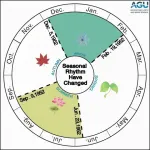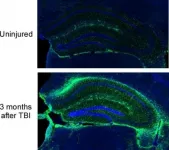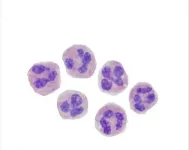(Press-News.org) Inflammation in the body has been linked to the intensity of tobacco smoking among people with HIV, according to a team of University of Massachusetts Amherst researchers.
Krishna Poudel, associate professor of community health education in the School of Public Health and Health Sciences, and colleagues reported positive linear relationships between intensity, duration and pack-years of smoking and inflammation in HIV-positive people. They believe it to be the first, more thorough examination of specific smoking-related variables with the levels of inflammation in this group, while also taking into account highly active antiretroviral therapy (HAART) and other important factors.
The study's findings suggest that people living with HIV would benefit not just from quitting smoking but from smoking less, says Poudel, co-director of the UMass Amherst Institute for Global Health. Poudel is lead author of the paper published in the March issue of the journal AIDS and Behavior.
"While it is important to support and encourage people living with HIV to ultimately quit smoking, it is also important to suggest they reduce the frequency of smoking until they can fully quit. That would also help their health status by reducing inflammation," says Poudel, noting that a high level of inflammation is linked to a greater risk of disease and death in people living with HIV.
Significantly, HIV-positive people who are receiving HAART have a greater risk of death from tobacco than from HIV-related factors.
In 2010, Poudel and co-author Kalpana Poudel-Tandukar, a UMass Amherst assistant professor of nursing, established the study cohort known as Positive Living with HIV (POLH). The public health researchers collaborated with five non-governmental organizations (NGOs) to recruit 322 HIV-positive people living in Nepal's Kathmandu Valley. Their goal was to gather behavioral, health and biologic information from participants to learn ways to improve the health and well-being of HIV-positive people, especially those in low- and middle-income countries.
The smoking and inflammation paper, whose UMass Amherst co-authors also include epidemiologist Elizabeth Bertone-Johnson and biostatistician Penelope Pekow, is the 18th publication in a peer-reviewed journal related to the POLH cohort study.
For the latest investigation, the researchers interviewed 284 study participants, gathering details about their smoking and medical history and other relevant information, such as whether they were receiving HAART. They asked about how many cigarettes were smoked per day (intensity) and for how many years (duration). Lifetime smoking exposure was gauged in pack-years, which is determined by multiplying the number of packs smoked daily by the number of years the person has smoked.
The team then measured serum C-reactive protein (CRP), a pro-inflammatory biomarker, and several strong predictors of inflammation in the participants. They adjusted for these variables while examining the relationships between smoking and inflammation, using both linear and logistic regression statistical analyses.
"We adjusted for zinc levels and hepatitis C. We adjusted for HAART status and CD4 cell counts. We adjusted for depression and the history of injected drug use," Poudel says. "We adjusted a total of 16 HIV-related symptoms, as well."
In each of the dose-response categories, researchers found a positive relationship between smoking and inflammation, although Poudel points out that the study's cross-sectional design cannot determine causality.
"A significantly higher proportion of the participants with high intensity of smoking (number of cigarettes smoked per day) had high levels of CRP concentrations compared to those with low intensity of smoking status," the paper states.
The researchers found similar results for smoking duration and pack-years of smoking; that is, participants who had smoked for longer periods and those who had greater pack-years were more likely to have high levels of CRP than those who had smoked for shorter periods and had fewer pack-years.
The important next step is to develop effective smoking reduction and cessation programs for HIV-positive people, whose tobacco use rate is two to three times higher than that of the general population. This is especially important in low- and middle-income countries, where such education and support are rarely available, Poudel says.
"Many HIV-positive people in low- and middle-income countries are willing to quit smoking and need support," Poudel says. "Our findings highlight an urgent need for providing smoking cessation support to HIV-positive people. While supporting HIV-positive people for quitting smoking is a critical public health priority, HIV care providers should encourage their patients at least to reduce the frequency of smoking, as this would be a positive step toward ultimately quitting smoking."
INFORMATION:
WASHINGTON--Without efforts to mitigate climate change, summers spanning nearly six months may become the new normal by 2100 in the Northern Hemisphere, according to a new study. The change would likely have far-reaching impacts on agriculture, human health and the environment, according to the study authors.
In the 1950s in the Northern Hemisphere, the four seasons arrived in a predictable and fairly even pattern. But climate change is now driving dramatic and irregular changes to the length and start dates of the seasons, which may become more extreme in the future under a business-as-usual climate scenario.
"Summers are getting longer and hotter while winters shorter and warmer ...
Nursing homes with the largest proportions of non-White residents experience 3.3 times more COVID-19 deaths than do nursing homes with the largest proportions of White residents, according to a new study from the University of Chicago. The paper, published in JAMA Network Open, suggests that these differences are likely due to nursing home size and the level of coronavirus spread in the local community, reinforcing the inseparability of long-term care facilities from society at large when it comes to bringing the COVID-19 pandemic to heel.
Since the start of the ...
Traumatic brain injury (TBI) is a major cause of disability and a risk factor for early-onset dementia. The injury is characterized by a physical insult followed acutely by complement driven neuroinflammation. Complement, a part of the innate immune system that functions both in the brain and throughout the body, enhances the body's ability to fight pathogens, promote inflammation and clear damaged cells. Complement plays a role in the brain, regardless of infection or injury, as it influences brain development and synapse formation. In TBI, complement- induced inflammation partially determines the outcome in the weeks immediately following injury. However, more research is needed to define a role for the complement system in neurodegeneration ...
For cancer cells to metastasize, they must first break free of a tumor's own defenses. Most tumors are sheathed in a protective "basement" membrane -- a thin, pliable film that holds cancer cells in place as they grow and divide. Before spreading to other parts of the body, the cells must breach the basement membrane, a material that itself has been tricky for scientists to characterize.
Now MIT engineers have probed the basement membrane of breast cancer tumors and found that the seemingly delicate coating is as tough as plastic wrap, yet surprisingly elastic like a party balloon, able to inflate to twice its original size.
But while a balloon becomes much easier to blow up after some initial effort, the team found that a basement membrane becomes stiffer as it expands. ...
Found around the world, powdery mildew is a fungal disease especially harmful to plants within the sunflower family. Like most invasive pathogens, powdery mildew is understudied and learning how it affects hosts can help growers make more informed decisions and protect their crops.
Scientists at the University of Washington and the University of Central Florida inoculated 126 species of plants in the sunflower family with powdery mildew, growing 500 plants from seeds that were collected from the wild and provided from the USDA germplasm network. Through this ...
BOSTON - The higher rates of obesity in Black, Indigenous and People of Color (BIPOC) compared with other groups in the United States can be attributed in large part to systemic racism, according to a new perspective article published in the Journal of Internal Medicine. The authors offer a 10-point strategy to study and solve the public health issues responsible for this disparity.
"First, it is important to recognize that the interplay of obesity and racism is real. Once persons recognize this, they can begin to appropriately address and treat obesity in BIPOC communities," says co-author Fatima Cody ...
Women who experienced hypertensive disorders of pregnancy (HDPs) but did not develop chronic hypertension have a greater risk of premature mortality, specifically cardiovascular disease (CVD)-related deaths, according to a study published in the Journal of the American College of Cardiology (JACC). A separate JACC study examined the cardiovascular health risks associated with pregnancy in obese women with heart disease.
HDPs, which occur in approximately 10% of all pregnancies worldwide, are among the most common health issues during pregnancy. There are four types of HDPs: chronic hypertension, gestational hypertension (GHTN), preeclampsia and ...
Other senses re-routed during evolution, but not sense of smell
Loss of smell linked to depression and poor quality of life
Smell research can help treatments for loss in COVID-19
CHICAGO ---Odors evoke powerful memories, an experience enshrined in literature by Marcel Proust and his beloved madeleine.
A new Northwestern Medicine paper is the first to identify a neural basis for how the brain enables odors to so powerfully elicit those memories. The paper shows unique connectivity between the hippocampus--the seat of memory in the brain--and olfactory areas in humans.
This new research suggests a neurobiological basis for privileged access by olfaction to memory areas in the brain. The study compares connections between primary sensory areas--including ...
Researchers have developed a spectroscopic microscope to enable optical measurements of molecular conformations and orientations in biological samples. The novel measurement technique allows researchers to image biological samples at the microscopic level more quickly and accurately.
The new instrument is based on the discrete frequency infrared spectroscopic imaging technique developed by researchers at the Beckman Institute for Advanced Science and Technology at the University of Illinois Urbana-Champaign.
"This project is about bringing the study ...
DALLAS - March 8, 2021 - A study led by UT Southwestern and Children's Health researchers defines parameters for the number of white blood cells that must be present in children's urine at different concentrations to suggest a urinary tract infection (UTI). The findings, published recently in Pediatrics, could help speed treatment of this common condition and prevent potentially lifelong complications.
UTIs account for up to 7 percent of fevers in children up to 24 months old and are a common driver of hospital emergency room visits. However, says study leader Shahid Nadeem, M.D., assistant professor of pediatrics at UTSW as well as an emergency department physician and pediatric nephrologist at Children's Medical Center Dallas, these bacterial infections ...






